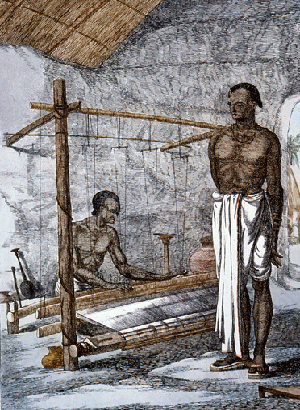
Muslin weaving taking place on a handloom at a designated karkhana, or at the weaver’s home, under the watchful eyes of a gomostha (royal supervisor) – 18th century.
Whilst contemporary definitions about muslin have undergone alterations, historically muslin was a cotton fabric characterised by its extraordinary lightness as well as distinctive motifs.
The original muslin fabric was produced solely from a cotton plant called ‘phuti karpas’ that grew exclusively along the banks of a certain stretch of East Bengal’s lower Brahmaputra river. The extracted cotton was then hand-spun into an extraordinarily delicate yarn in villages near Dhaka, Bangladesh,e.g. Jangalbaree, Shonagragon, Teetbari, Dhamrai, Bajitpur, and others.
The finished cloth, woven on looms that have barely altered over the centuries, was sought after by royalty and traded globally across the Middle East and Europe during the 16th and 17th centuries, earning enormous wealth for those involved in its trade.
According to the Portuguese writer J.J.A. Campos, ‘there were times when the muslins of Dacca shipped from Satgaon clad the Roman ladies and… were very much appreciated there and fetched fabulous prices.’ By the eighth century, Arabian ships travelling via the Indian Ocean were carrying huge volumes of Bengal’s cotton textiles to Basra and Baghdad and Java and China to the east. Ibn Battuta (14th century traveller) wrote that among the presents sent by the Delhi Sultan Muhammad ibn Tughluq to the Yuan Emperor in China were one hundred pieces named as ‘bayrami, salahiyya, shirinbaf and shanbaf’.
Tragically, the industry was systematically destroyed in the 19th century by the East India Company, and replaced with machine-made fabrics. As a result the plant, along with associated spinners and weavers and their skills, vanished into the mists of history.
Over the past few years Bengal Muslin has collected some selected samples of original muslin (mainly from collections) as a reminder of our past glory and has also woven different varieties of muslin that recreate the ones worn in the past.
– Linschoten Jan Huyghen van Linschoten, Dutch merchant, trader and historian, (1563 – 1611)
We have addressed some of the common queries about muslin in a series of ‘one pagers’ ranging from the tale of thumbs being cut to the variety of fabrics that are known as muslin today. To know more about this magical fabric, click on the links below and read on:


